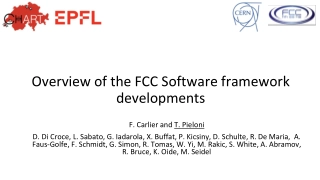Electrical Distribution Concept and Layout at FCC Week
Presentation at FCC Week 2022 focused on load requirements, high voltage network scheme, downstream electrical distribution for various points, and a preliminary load flow analysis. The update on load requirements includes P sizing, updates on RF systems, preliminary load surveys, and separation of required loads. The content highlights the distribution concept and layout for efficient energy management at CERN.
Download Presentation

Please find below an Image/Link to download the presentation.
The content on the website is provided AS IS for your information and personal use only. It may not be sold, licensed, or shared on other websites without obtaining consent from the author.If you encounter any issues during the download, it is possible that the publisher has removed the file from their server.
You are allowed to download the files provided on this website for personal or commercial use, subject to the condition that they are used lawfully. All files are the property of their respective owners.
The content on the website is provided AS IS for your information and personal use only. It may not be sold, licensed, or shared on other websites without obtaining consent from the author.
E N D
Presentation Transcript
ELECTRICAL DISTRIBUTION CONCEPT AND LAYOUT Charline MARCEL, Mario PARODI (CERN EN-EL) TIWG Electricity & Energy Management WP FCC week 2023
Content Baseline presented at FCC week 2022 Update on the load requirements Load mapping of the machine High Voltage network scheme Downstream electrical distribution for RF points Downstream electrical distribution for other points Conclusion and next steps
4 Baseline presented at FCC week 2022 Highly unbalanced load request: - Radio Frequency systems at points H and L - Unbalance between phases of the machine 3 Connection points to RTE grid (PD, PH, PL) Internal 132 kV transmission loop All points would have a 132/36 kV substation FCC-ee H [MW] 200 180 160 140 120 100 80 60 40 20 0 PA PB PD PF PG PH PJ PL FCC-ee ttbar [MW] 160 140 120 100 80 60 40 20 0 PA PB PD PF PG PH PJ PL + preliminary load flow analysis had been done based on this grid
5 Update on the load requirements P_sizing (MW) 17,0 4,8 20,2 6,1 2,1 20,2 17,0 4,8 20,2 6,1 2,1 20,2 17,0 4,8 20,2 42,2 169,5 20,2 17,0 4,8 20,2 18,6 26,9 20,2 P_sizing (MW) 184,0 44,9 74,1 91,8 36,8 19,4 14,0 6,0 34,0 505,0 surface underground PA - PB Main update: - RF (Radio Frequency system) of the colliders at Point H - RF of the booster at Point L RF Cryo CV Magnets Vacuum Transport Experiments Data centers General services Total PA surface underground PB - PD PB Other updates: - Preliminary load survey done to main users identified: Cooling & Ventilation (CV) Cryogenic systems (Cryo) Transport - Refinement of the estimation of the loads for General Services: Lighting, power outlets surface underground PD - PF PD surface underground PF - PG PF surface underground PG - PH PG Estimation not supported by any detailed load request surface underground PH - PJ PH Separation of: - Total required loads for the sizing (as if simultaneity = 1 all the time) - Loads predicted to be consumed with simultaneity (when details on the consumption already known) - Locations of loads: at a point on surface, underground, and in an arc between two points surface underground PJ - PL PJ surface underground PL - PA PL Example of preliminary estimations VACUUM INSTAL. P_consumed (MW) 74,57 STOP RUN Consumed loads requirements lower (at maximum should be below 400 MW for the whole machine) P_consumed (MW) 88,64 P_consumed (MW) 379,70 TOTAL
6 Load mapping of the machine Based on users requests developed by points and facilities where available (underground sectors) Preliminary requirements updates and modifications are expected Radio Frequency systems at points H (colliders) and L (booster): hot points Loads still unbalanced between phases of the machine (Z, W, H, ttbar) Categorization of loads: Power unavailability duration in case of degraded scenario Loads class Loads type (non-exhaustive list) Power converters, RF, cooling pumps, fan motors, etc. Machine Until return of main supply General Services Until return of main or secondary supply Lighting, outlets Personnel safety related loads (lighting, pumps, elevators) Personnel safety (evacuation and anti-panic lighting, fire-fighting system, oxygen deficiency, evacuation) Machine safety (sensitive processing and monitoring, beam loss, beam monitoring, machine protection) Secured 10-30 s Interruptions not allowed, continuous service mandatory Uninterruptable
7 High Voltage network scheme Open loop Closed loop Reliability principles: - n-1 respected except for loss of the source of PH - Loss of the source of PH will stop the machine - Cost/benefit analysis to be performed Voltage level on the HV (High Voltage) transmission network to interconnect points ? Strategy for the location of HV substations ?
8 High Voltage network scheme Voltage level analysis Branch losses Line charging Voltage level Cables on the loop 132 kV 1x 400 Cu (145kV) 1x (3x81mm diam.) 66 kV 2x 400 Cu (72,5kV) 2x (3x67mm diam.) 40 kV 4x 300 Cu (72,5kV) 4x (3x64mm diam.) Dimensions 3 voltage level studied: - 132 kV (baseline from FCC week 2022) - 66 kV (currently used at CERN) - 40 kV (voltage level asked by converters) & Optimization made on 3 parameters: - Capex (price of cables, cable trays, installation) - Opex (price of operation, electrical losses) - Space occupation Optimization of the power lines characteristics (to have them up to 75% of charge) This choice will also impact the location of the HV substation (underground or surface) Cost/benefit analysis ongoing to select the best voltage level Preliminary results: The higher the voltage, the smaller the losses, and the lower the voltage, the more cables in parallel needed But the higher the voltage, the more expensive the prices of equipment and the space occupation of substations Also, the line charging current increases with the voltage, but it does not seem to be a critical parameter provided that the voltage regulation strategy will follow it (not yet analyzed) From a space occupation point of view, the 40 kV seems not applicable for the overall transmission network (For the real sizing: use of standard voltage levels)
9 High Voltage network scheme For more details on the electrical distribution of the alcoves: Tuesday 6thJune at 3:52pm Alcoves: requirement, integration and cabling concept Underground High Voltage network scheme Solution in investigation: underground HV/MV substations Benefits: - Power at High Voltage (HV) closer to the main loads - Avoid a double cabling between surface and underground Disadvantages: - Space occupation underground - Technologies adapted for underground more expensive (and today considered feasible up to 72.5 kV) - Cooling of the underground galleries
10 Downstream electrical distribution for RF points Machine Z W H ttbar Collid. 400-kly 112 x 149 134 Boost. 800-kly 12 x 8 6,8 Collid. 400-kly 132 x 175 133 Boost. 800-kly 14 x 9,4 6,7 Collid. 400-kly 132 x 175 133 Boost. 800-SS x 108 10,5 8,2 Collid. 400-SS x 264 42,8 33,4 Collid. 800-kly 244 x 164 106 Boost. 800-SS x 150 13,8 7,8 RF frequency - type # of klystrons # of S.S. modules Tot. Installed [MW] Tot. El consumption [MW] Point H: Point L:
11 Downstream electrical distribution for RF points Klystrons galleries
12 Downstream electrical distribution for other points Maximum values for loads, to size the substations and links
13 Conclusion and next steps Today In the future Iterations to update 3D electrical integration of tunnels, galleries and alcoves still to be performed: an impact on the current baseline of integration is expected, item to be addressed by the end of 2023 Summary of updated requirements for cooling and ventilation still to be performed: to be addressed by the end of 2023 Feasibility study for the installation of a High Voltage cable in the tunnel will be launched in 2023 Study of secured network will start by the end of 2023 The progress on the users requirement definition allowed to develop the baseline of 2022 FCC week The concept of underground transmission network and substations has been studied and is the object of a cost/benefit analysis The selection of the voltage transmission level is under finalization The power flow of the main links is being assessed taking into account a n-1 scenario Power supply of RF points well developed Concept and preliminary sizing of underground distribution well developed Users power requirements still under definition, and studies still ongoing: the presented results shall be considered preliminary
14 Conclusion and next steps Opportunities: Staging (if compliant with FCC reliability and availability requirements): HV substations and transmission loop Downstream electrical equipment (e.g. RF supplies) FCC-hh: High-level infrastructure ready Possible re-use of electrical systems installed in RF points of FCC-ee Integration of internal renewable power generation Use of DC alternative solutions to at least part of the powering infrastructure, e.g. supply of power converters Comparison of AC-DC solutions in the pipeline of the WG Still the connection to RTE AC grid shall be ensured For more details on the DC alternatives: Thursday 8thJune 9:24am by Manuel Colmenero Moratalla DC Networks for the Powering of the FCC
15 Thank you for your attention























